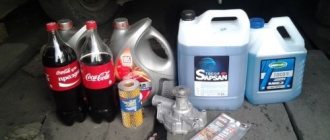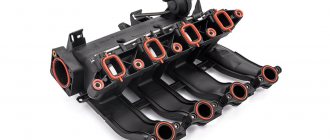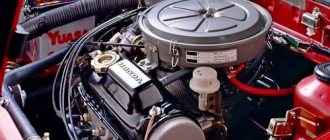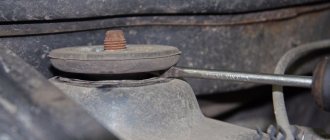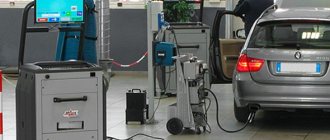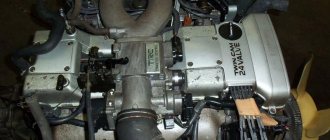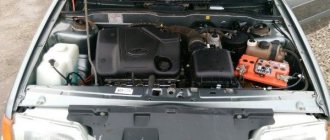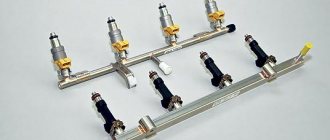How many liters of Antifreeze in a VAZ-2110 with an 8-valve engine
Car : VAZ-2110. Asks : Stas Salomatnikov. The essence of the question : I want to completely drain the antifreeze and flush the system, how much antifreeze should I buy?
Yesterday I looked into the coolant reservoir and was horrified, there was some kind of dirt and foam. In the winter it’s still normal, but in the summer it will be a mess. The honeycombs on the radiators will get clogged, so I don’t want to force the car. I want to completely flush the cooling system and replace the antifreeze.
How much antifreeze does a VAZ-2110 need in general? My car has 8 valves.
Volume of antifreeze VAZ 2112 16 valves
Good day to all. This is my first entry in the logbook and let's hope it's not the last.
Once again I looked under the hood to check the fluid level, and was horrified: in the expansion tank, instead of the antifreeze I had filled in about two thousand years ago, there was some kind of brown, rusty-colored liquid.
I decided not to put this matter off for a long time and in the VKontakte group for the 10th family I began to wonder what the consequences of driving on such antifreeze would be. The answers were not encouraging: the radiator honeycombs would become clogged, the car would overheat, engine cooling would become worse, etc. Well, that means it definitely needs to be changed. And here the number of questions has increased significantly: with what and how to properly flush the 2110 cooling system, what to fill: antifreeze or antifreeze, if antifreeze, then what color: green or red, what are their differences and which is better for the 10.
Below I have prepared answers to these questions, which I read on websites, forums, in VK and which I derived for myself.
What to wash with.
You can rinse with all sorts of special liquids, which are sold in the store from 250 rubles per bottle, or you can use citric acid, in a proportion of 130-150 grams per 8 liters of water, as I did. The price of a 10 gram sachet of citric acid is 6 rubles. Coca-Cola is no help in this matter - orthophosphoric acid, which removed scale and rust, was excluded from its composition, so we leave cola to be used together with whiskey. I also read that some guys disconnected one pipe from the barrel and connected a hose with water under it. pressure, then opened the faucet on the radiator and the plug on the block and washed it in this way. I think that this is an ineffective method, since hot water will remove much more dirt, and a large circle will not be washed in this way - the thermostat will not open due to the low temperature of the running water.
Antifreeze or antifreeze.
This was a difficult question for me, but I gave preference to antifreeze - progress does not stand still, so I decided to use a newer development. Yes, and they encouraged comments on VK, saying that the frieze does not corrode as much as antifreeze. I haven’t looked at water at all and I don’t look at it at any time of the year, since it is because of water that scale appears, the entire cooling system rusts from the inside and the radiator honeycombs become clogged with the same rust. Antifreeze differs from antifreeze, but not as fundamentally as some imagine - the boiling point of the latter is higher and there is a story with additives, but in fact it is the same thing. If you are interested, google: the differences between antifreeze and antifreeze. Well, the price, accordingly, varies - antifreeze will be more expensive. Personally, in my area (Murmansk region), the difference between 10 liters of liquids is 200-300 rubles. Thus, if you have a leaky cooling system and you often top it up, then it’s better to use antifreeze - you’ll save your money, and if it doesn’t flow in three streams - frieze. Remember: you cannot mix antifreeze and antifreeze. Different colors of frieze are possible, but antifreeze with antifreeze is not possible.
Features of Antifreeze
Antifreeze is responsible for cooling the engine. Without it, the engine will not be able to operate normally, as it will simply overheat.
Antifreeze is sold in cans of various capacities.
Therefore, every VAZ-2110 owner needs to know how many liters of antifreeze should be in the car, and when it needs to be changed in order to ensure normal functioning of the internal combustion engine.
Timely maintenance not only guarantees the durability of the vehicle, but also makes it possible to save on repairs. The situation is the same with antifreeze.
High-quality antifreeze must meet the requirements of GOST.
Advantages
- It does not expand like water when heated and boils at a higher temperature.
- Doesn't freeze in sub-zero temperatures.
- Doesn't foam.
- Does not corrode metal and plastic.
How much antifreeze is needed in a VAZ-2110?
A car of this brand will need to be filled with about 7-8 liters of liquid.
It is recommended to purchase antifreeze from trusted manufacturers.
This will ensure normal cooling in the system. Sometimes when pouring it may seem that 5-6 liters . But that's not true. Antifreeze cannot immediately fill the entire system, and therefore it must be filled correctly.
After pouring antifreeze, you need to let the engine idle for some time. Then open the expander plug and add fluid to the system. Topping up should be done with the engine turned off, when it has cooled down.
If there is little liquid in the system, it will boil faster and will not be able to fully cool the engine . It is also important to monitor the excess fluid in the system. In this case, it may tear the pipes or the tank itself. There are usually marks on the tank with the minimum and maximum antifreeze points in the system.
The antifreeze level in the expansion tank should be between the MIN and MAX marks.
Draining antifreeze
In the VAZ-2110 it should be changed after a mileage of 150,000 kilometers.
Typically, antifreeze is changed every 5 years or after 150 thousand kilometers.
It is not recommended to exceed this figure. But sometimes in practice it may be necessary to replace antifreeze prematurely. This should be done when:
- The fluid in the reservoir has a film of oil.
- There is rust in the liquid.
- The engine often boils.
- There is a fluid leak.
Antifreeze is changed ahead of schedule if it has darkened, but first the cause is established.
Recommendations
What should you consider when replacing antifreeze? To carry out filling correctly, you must adhere to the following rules :
- Fill in the brand of antifreeze that was previously in the system.
- Give preference to a quality product from a reputable manufacturer. This way you can increase the service life of the motor.
- Filling should only be done into a cold engine.
Before filling in new antifreeze, it is recommended to flush the cooling system with special cleaners.
What are the differences between antifreeze?
Antifreeze consists of ethylene glycol, which is diluted in a certain proportion with distilled water. Unlike the imported product, it contains up to 50 percent water. Antifreeze is a concentrate that needs to be diluted yourself.
Externally, antifreeze differs in color. It has a bluish tint, while antifreeze comes in different colors. It could be:
- Green (G11 group).
- Red or yellow (G12).
- Violet (G12).
The characteristics of antifreeze can be compared with those of group 12 antifreeze.
As you know, the first “ten” models were equipped with engines of an old design with an 8-valve timing mechanism. In the early 2000s, the famous “shesnar” appeared in the lineup, which car owners loved so much for its high power and efficiency. This timing mechanism has its pros and cons. But during maintenance, the question arises of how much antifreeze to pour into the VAZ-2110.
The official answer from the manufacturer is the same 7.8 liters. Why is this figure the same for engines with 16 and 8 valves? No matter how much antifreeze you pour into the VAZ-2110, the norm will remain the same. And all because the block for these engines is the same. And there is no cooling in the valve cover. This volume of antifreeze is quite enough to cool both the block and the “head”.
Required amount of coolant for VAZ 2110
After a certain mileage and operation of the VAZ 2110 car, it is necessary to carry out a technical inspection, monitor the level of oil and coolant in the system. After a certain period of operation, all lubricants and coolants lose their original technical and operational characteristics and require replacement. Therefore, before replacing the coolant, you need to find out how much antifreeze is in the cooling system of the VAZ 2110.
Many inexperienced car enthusiasts, when replacing antifreeze or antifreeze in a car's cooling system, fill in 5-6 liters of fluid and make sure that it has reached the maximum level in the expansion tank, consider this sufficient and close the hood of the car.
This is their big mistake , since the antifreeze has not yet had time to completely fill the system.
You need to wait about five minutes until the liquid level in the tank drops significantly. Accordingly, you will need to add more coolant. This procedure must be done several times, only then will it be clear how many liters of antifreeze are in the VAZ 2110 cooling system. It is necessary to add fluid until its level stops at one mark, which should be above the minimum and below the maximum level. Not adding enough antifreeze or antifreeze can cause the engine to overheat and fail. It is also impossible to overfill coolant, since when heated it tends to increase in volume.
After pouring antifreeze (antifreeze), you need to perform the following steps:
- close the expansion tank cap;
- start the engine and wait until it warms up before turning on the fan;
- turn off the engine and let it cool down;
- Check the coolant level in the tank and top up if necessary.
A VAZ 2110 needs to be filled with approximately 8 liters of coolant. This is a rather important procedure on which the life of the car engine depends.
The process of replacing coolant on a VAZ-2112
Before proceeding directly to the replacement process, it is necessary to select the appropriate tools. So, to complete the process you will need:
- Ratchet with 13mm head.
- The key is 17.
- Key for 10.
- Container for liquid.
- Funnel for the bay.
When the tools have been selected, you can proceed directly to the process. It is worth noting that replacing the coolant is carried out when the car has cooled down, so it is best to let it cool down after a trip for about an hour, depending on the ambient temperature. So, let's look directly at the replacement process itself:
- Having placed the car on a pit or a lift, using a 10mm wrench we dismantle the engine protection.
- Unscrew the cap of the expansion tank.
Unscrew the expansion tank cap. The photo shows the editor's car, this is what the coolant tank looks like, it's still original, the car is from 2003, the mileage is 170,000 km
To drain most of the fluid, unscrew the drain plug on the cylinder block.
To completely drain the liquid, remove the cap from the radiator.
This is how antifreeze will flow from the engine
If necessary, you can change the thermostat and pipe clamps that are worn out.
Antifreeze or antifreeze
Antifreeze versus antifreeze - which is better?
Motorists often face the question of what is better antifreeze or antifreeze? Of course, in terms of technical and physico-chemical characteristics, antifreeze is inferior to antifreeze. The second one is better to use in winter, since it has many additives that have a lower freezing point and a higher boiling point.
Of course, the manufacturer recommends using antifreeze, since it is designed specifically for cars of the VAZ family. Of course, price plays a very important role, where antifreeze loses to its competitor. Therefore, in the end, we can say that both types of coolant can be used for VAZ.
Optimal coolant option
When you have figured out how to replace antifreeze on a VAZ 2110 (2112), it is important to choose the best fluid option . Many car enthusiasts only use expensive antifreeze, considering it to be of higher quality. For VAZ cars, it is quite possible to use a cheap domestic product - antifreeze, the characteristics of which were developed specifically for these cars.
Owners of domestic cars respond positively to Felix brand antifreeze. It is sold in canisters of 5 and 10 liters, and smaller containers. It is profitable to purchase liquid in a 10 kg container - it is cheaper, and after replacing the used antifreeze, there is still liquid left for refilling.
Coolant characteristics
So let's start with the definition. What is antifreeze? This is a coolant developed by Soviet scientists in the 70s. It was this that was used for the first Zhiguli cars. Subsequently, the coolant began to be used on the VAZ-2110. The car rarely needed to replace antifreeze - only once every two years. But antifreeze has an even longer lifespan.
- Anti-foam. To prevent air from forming in the system and reducing heat dissipation.
- Anti-corrosion. Over time, system components may rust. Dirt particles clog small channels and prevent normal fluid circulation. These additives are also called corrosion inhibitors.
The liquid also has an anti-scale additive.
When ordinary water boils, it forms a characteristic white coating on the walls. This significantly impairs heat dissipation. As a result, the machine heats up even with the fans on. If the coolant boils, it does so at a temperature of at least 105 degrees Celsius and does not emit deposits.
The manufacturer recommends using domestic antifreeze for VAZ cars of the “tenth” family (including station wagons and hatchbacks). This liquid is poured into the car from the factory. Antifreeze is a Soviet development of the 70s. It is an analogue of imported antifreeze. But the cost is a little cheaper. Just like in antifreeze, several additives are used here:
- Anti-foam.
- Anti-corrosion, etc.
What is the volume of coolant in a VAZ 2110
AutoNews / Reviews / Tests
How many liters of coolant in VAZ 2110
The best volume of antifreeze in the VAZ-2110 cooling system
Surely, you have more than once seen cars on the side of the road with steam emanating from under the hood. Every car owner, including a VAZ-2110, faces this at some point. The advantage of Russian cars is that you can service them with your own hands, without turning to 100 people for help.
The condition of the cooling system directly affects the operation of the engine, the heater in the cabin and the life of the car. If the cooling system fails, other parts also malfunction, and later stop working altogether and must be completely replaced.
Antifreeze and car cooling system
The purpose of the internal combustion engine cooling system is explained in its name: it helps remove excess heat from the engine, which can damage the part. The key component of the system is the coolant, which is also called “anti-freeze” or antifreeze. This substance is dangerous for humans, but for a car it is an indispensable component. After all, for its correct operation, the engine temperature should not exceed 90 degrees Celsius.
View gallery
Antifreeze is not only involved in cooling the car engine, it also helps reduce the temperature of the oil and is involved in the operation of the air conditioner. The cooling function is especially important in the hot season, when on the roads you can often see overheated cars with steam coming from under the hood. To prevent this from happening, you need to change the fluid on time, monitor the serviceability of the system and promptly repair leaks.
How the VAZ-2110 cooling system works
After turning on, the engine begins to heat up, the usual heating temperature for the device varies between 80-90 degrees, after which the unit may burn out. The cooling system allows the engine to quickly warm up and maintains the temperature while the vehicle is moving.
Coolant (antifreeze) circulates through the mechanism, bypassing the radiator, mostly in a small circle, evenly moving to a larger circuit. After that, the pump of the pumping mechanism ensures the flow of water to the radiator, and the temperature sensor records the moment at which saturated cooling is needed and also regulates the operation of the fan.
The temperature in the cabin depends directly on the state of the cooling system. If the latter does not work or does not work correctly, the stove turns off.
Common malfunctions in the VAZ-2110 cooling system
Auto repair experts identify the following main faults that affect the cooling system:
- leakage of antifreeze and its deficiency;
- due to a malfunction of the pump pump there is no pressure;
- the fan that promotes cooling works erroneously or does not turn on at all, this is due to errors in the operation of the temperature sensor;
- the thermostat is inoperative, which prevents the circulation of the solution along the large cooling circuit;
- contamination of the plates installed in the radiator.
Monitor the condition of the machine and immediately respond to the occurrence of third-party sounds when the pump pump is turned on.
Experts recommend monitoring the level of coolant in the tank and replacing the old one with a new one every 75,000 km of the VAZ-2110.
Replacing coolant: antifreeze or antifreeze on VAZ 2110, 2114, 2115 injector
Coolant replacement procedure
on all injection 8-valve VAZs: 2108, 2109,
2110
, 2111, 2112, 2113, …
Replacing coolant (antifreeze) on VAZ 2110, 2114, 2115 injector
Subscribe to my VK group.
To determine whether there are any temperature errors, periodically refer to do-it-yourself methods for diagnosing the cooling system. The radiator, which is responsible for cooling, requires regular cleaning and temperature control when the engine is running.
content .. 46 47 48 49 ..Lada VAZ-2110 (2111, 2112). Gasoline (fuel) enters the engine crankcase
Fuel in the lubrication system crankcase
There is a problem of an abnormal increase in the oil level in the crankcase, when the lubricant smells strongly of fuel. In a two-stroke engine, the fuel is a mixture of gasoline / oil, but in a four-stroke internal combustion engine, these two liquids should not mix. The circulation of lubricant in a working engine occurs in a closed circuit: crankcase - cylinder block - fuel filter - oil pump - cylinder head - cylinder block - crankcase. A strong smell of fuel coming from the dipstick, which measures the oil level, indicates that gasoline may have gotten into the oil, and you should look for the reasons.
Signs of a Leak
The driver can know that a leak has occurred by seeing a black puddle under the car. Oil may leak from the valve cover gasket, damaged oil seals, or damaged crankcase gasket. When leaking into the external environment, oil, as a rule, does not mix with other motor fluids. The oil/gasoline mixture can only form inside the engine and only under certain circumstances. Cases when motor oil gets into the fuel also occur outside the car, for example at a gas station or due to the negligence of the owner who mixed up the canisters. It is unrealistic to separate these substances in a garage, and pouring such a mixture into the tank (except for two-stroke engines) is strongly not recommended. You can notice that there is a significant amount of fuel in the lubricant by other signs: the consistency of the lubricant has changed, it has become more liquid; the grease on the dipstick flashes when ignited with a match; a drop of grease on paper leaves a greasy, expanding halo around itself, which quickly evaporates. If these signs are present, then it’s time to visit a car service center. The rule of looking under the hood of a car at least once a week and checking the level and condition of lubricant, brake fluid and antifreeze will be a good habit for any driver, regardless of the make of the car. Detecting a leak early will save time and money.
Causes of fuel leakage into the lubricant
Gasoline, regardless of the type of engine power supply system, after the gasoline pump must flow through the shortest route to the final destination - the carburetor (injectors) and then into the combustion chamber. The combustion chamber is the space between the cylinder head and the piston head, where the working combustion of the gasoline/air mixture occurs. On the way to the combustion chamber, the air-fuel mixture passes the intake valves, the necks of which are constantly lubricated by oil circulating in the system. Many people assume that there may be a leak in this place, and very often they are right. The fact is that the valves are equipped with oil deflector rubber caps. They are designed to prevent the oil that lubricates the valve journals from being reflected from them into the combustion chamber. If, due to severe wear of the caps, oil gets there, then the smell of the car’s exhaust gases will resemble that of a motorcycle, and smoke from the exhaust pipe will come out in a thick bluish cloud. The probability that the fuel-air mixture, sprayed in the intake manifold and moving at high speed into the combustion chamber along the same path, will enter the lubrication system is very small - the difference in pressure will draw the mixture into the cylinders. This means that the reasons why the oil smells like fuel should be looked elsewhere. When starting in cold weather, the fuel in the first few minutes of operation does not burn as efficiently as on a warm engine. The exhaust often smells like raw gasoline that has not fully ignited in the combustion chamber, and condensation may drip from the exhaust pipe. This is normal and has nothing to do with the problems described below.
Gasoline pump
The design of the fuel supply system may differ in different car models. In modern cars with injection engines, gasoline is pumped using an electric pump, in which oil and fuel cannot physically meet, unlike carburetor cars that are standardly equipped with a mechanical fuel pump. The diaphragm of a mechanical pump forces gasoline into the carburetor. The pump rod in some brands of cars is driven by an eccentric and receives oil from the same environment as the camshaft. If the diaphragm is torn, gasoline can flow into the rod channel, and once again checking the lubrication level with a dipstick, the driver may notice that the oil has a characteristic smell. If the fuel pump membrane is slightly damaged, the lubricant level may remain the same, but if the membrane is significantly ruptured, gasoline will no longer be pumped effectively into the carburetor, the car will have difficulty starting, and problems may occur while driving. The problem is eliminated by replacing the membrane with a new one from the fuel pump repair kit. Of course, not many people pay attention to the smell of lubricant, but sometimes the smell of gasoline is very strong, which rightfully causes concern.
Injector nozzles
In an injection engine, the smell of fuel coming from the dipstick may indicate a malfunction of the injectors or ignition system. In the first case, we are talking about the fact that one or more injectors do not close hermetically and after stopping the engine, fuel seeps into the manifold due to residual pressure, from where it then enters the cylinders. Of course, the piston rings are a barrier to the crankcase, but if their level of wear is high and there is some obstruction, then they will not become an obstacle to the flow of fuel. It also smells like fuel if the ignition system is faulty. If a spark plug in one of the cylinders fails, the combustible mixture in it does not ignite and does not perform useful work. The fuel-air mixture is forced into the cylinder, where no spark occurs and part of the fuel flies out at the outlet, and part of it settles on the walls of the cylinders, again flowing into the crankcase, hence the smell. To eliminate this malfunction, remove the fuel rail and check the tightness of each injector one by one by supplying kerosene or injector cleaning liquid from an aerosol can into it under pressure. Leaking injectors and damaged spark plugs are replaced with serviceable ones.
Common problems
So, we can generalize and highlight the same problem that occurs in both carburetor and injection type engines - a high level of wear on compression and oil scraper rings. This is where the fuel comes into contact with the lubricant. Fuel flows into the crankcase, lubricant rises into the combustion chamber - this vicious cycle indicates the need for a major engine overhaul. The power plant significantly loses power when compression decreases in at least one of the cylinders due to compression rings stuck in the grooves. Excess fuel in the combustion chamber produces an over-enriched mixture, which is also not good. The soot layer will grow, and frequent overheating will become inevitable. The dilution of the lubricant, and the resulting change in its viscosity level, is dangerous for an internal combustion engine operating under load at high speeds.
Consequences
Gasoline is a rather aggressive chemical substance. Modern internal combustion engine lubricators contain complex additive systems that are not designed for direct and prolonged contact with leaded fuel, which can change the physical and chemical properties of the lubricant. If the oil level on the dipstick has risen above o, and the oil has visually changed its consistency and has a characteristic odor, then measures must be taken immediately. Antifreeze can be mistakenly mistaken for gasoline, a drop in its level in the expansion tank, and the abnormal rise in the emulsion level in the crankcase may mean that the cylinder head gasket is broken. It is prohibited to start an engine with a broken gasket to avoid water hammer and wedge - the car will be towed to a service center with the clutch disengaged. Small amounts of gasoline in the lubricant, of course, cannot harm the operation of the engine, and it is impossible to notice that the fuel level is falling, but the driver should think about where it goes and how.
content .. 46 47 48 49 ..
Required volume of antifreeze for VAZ-2110
Beginners are interested in: how much antifreeze should be in the VAZ-2110 cooling system for the engine and heater to work properly? Experts answer that regardless of the number of valves - 8 or 16 - the coolant is always filled at a level of 7-8 liters.
When you pour liquid into a VAZ-2110, at first it may seem that even 5-6 liters is a sufficient volume of solution, but these conclusions are hasty. After filling with antifreeze to the maximum possible level, start the engine and leave it on until the cooling fan comes on.
As soon as the fan turns on, you should turn off the motor and wait for the unit to cool down. Re-check the antifreeze level in the tank; most often you need to add the substance to the required level. Why can saving be fraught? If the antifreeze level is below the minimum values for proper operation of the VAZ-2110, the engine will begin to overheat, exceeding the maximum permissible temperature.
You shouldn’t be overzealous either - when heated, the liquid expands rapidly in volume.
How to change antifreeze?
Antifreeze can be replaced independently or in maintenance shops. And if the last option does not cause any difficulties, then you will have to prepare for independent replacement. The procedure is not too complicated, but quite labor-intensive. What will be required for the work?
- A set of keys.
- Pliers with a screwdriver.
- Wide capacity of 8 liters for used liquid.
- Household gloves.
It is also most convenient to replace antifreeze if there is an inspection ditch or overpass. Otherwise, you will have to unscrew and remove the oil pan. It is mandatory to wear gloves (preferably waterproof), since coolants are very toxic. The following steps are very simple:
- Remove the cap of the expansion tank, thermostat and unscrew the radiator.
- Open the radiator tap.
- Drain the used liquid into a prepared container.
- Rinse the system with distilled water or special cleaning fluids that will remove rust and accumulated additives.
- In this case, you need to start the engine, which should run for 30-60 minutes. The longer the antifreeze has not been changed, the longer the car should work.
- Screw back the radiator and cylinder block caps.
- Fill with fresh coolant up to the mark on the expansion tank.
- Start the engine and let it run for a while.
View gallery
How to choose the right coolant
Antifreeze is superior to distilled water in terms of the following characteristics:
- Expands less when heated.
- It requires a high temperature to boil.
- It does not freeze, but takes a gel form.
- Serves as a good protective barrier against corrosion.
- Assumes anti-foam characteristics.
- Lubricates parts.
It is believed that another type of antifreeze has a longer service life, antifreeze is a domestic analogue. When choosing antifreeze, pay attention to a set of additives that ensure a stable state of inhibitors that protect metal engine elements from corrosion.
There is a special offer on our website. You can get a free consultation with our corporate lawyer by simply submitting your question in the form below.
What volume of antifreeze fits into 2110?
- Is it possible not to rinse when replacing antifreeze with antifreeze in a VAZ 2110 - 2 answers
- VAZ 110 engine heats up excessively - 2 answers
- The stove on the VAZ 2110 does not work - 3 answers
- Cooling system expansion tank 2110 inflates - 3 answers
- The temperature rises when the headlights are turned on in a VAZ 2110 - 2 answers
The filling volume of the VAZ 2110 cooling system is 7.8 liters . Check only with a cold engine. It is important not to forget that cool. The liquid is toxic and requires careful handling.
The fluid level in the expansion tank should be equal to the top edge of the belt that secures the tank.
Well, the answer to the question “how much antifreeze is in a VAZ 2110” is not entirely clear. There is a non-drained volume of coolant that remains in the system anyway. Therefore, in practice, somewhere around 5, maybe 6.5 liters of liquid are drained. Well, you need to fill in the same amount accordingly.
Subscribe
to our channel in
Index.Zen
Even more useful tips in a convenient format
VAZ 110 engine heats up excessively
Is it possible not to rinse when replacing antifreeze with antifreeze in a VAZ 2110
The engine cooling system on the VAZ 2110-2112 is probably the second largest in volume after the fuel tank, and for normal cooling and heating of the interior, the required level of coolant in the system should be
7.8 liters .
It is this volume that needs to be poured into the expansion tank when replacing antifreeze or antifreeze. During the replacement, it may seem to you that the filled 5 or 6 liters is a completely normal volume, but you should not rush to conclusions, since the antifreeze does not disperse throughout the system instantly. When you have filled the conservator to the maximum level, start the engine and let it run until the cooling fan comes on.
After this, you need to turn off the engine and wait until it cools down completely. Then we look again at the fluid level in the tank. If necessary, top up to the required level.
If the antifreeze is below the minimum, this may be the reason why the engine will constantly heat up above normal temperature. But it’s also not worth pouring above MAX, since when heated, any liquid tends to expand and increase its volume.
Lada 2110 › Logbook › Replacing coolant in the cooling system.
Good day to all. This is my first entry in the logbook and let's hope it's not the last.


